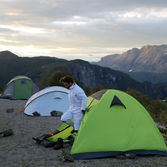
LUDVIG UHLBORS
ARNE NÆSS -THE SECT
A social sculpture in the expanded field of theatre
September 2017
Director Ludvig Uhlbors
Actors Arturo Tovar, Kjersti Aas Stenby
Set design & costume Kristine Gjems
Sound design Alexander Rishaug
Visual artists Hanna Sjöstrand, Kjersti Vetterstad
Performance artist Ann Cecilie Lie
Architect and designer of perma culture Kristin Astrup Aas

After the performance Bli Arne Næss the production team began to discuss the possibility of applying the philosophy of Næss in a different setting from Hallingskarvet. Næss always refered to his philosophy as site- specific, calling it Økosofi T; T being short for Tvergastein. When Uhlbors was invited to the Theatre festival in Fjaler the team decided to try to create an Økosofi F.
They moved into a house and began to decorate it according to their needs but realized very soon that their project had a potential to become problematic. What if the surrounding society would begin to think of them as sect members? It was decided that the best way to deal with this was to really become a sect. This way any risks that the project might carry had already been materialized. The decision put the various sect members at ease and allowed them to lay their critical thinking aside. They began to concentrate on the exploration of a Deep ecological life style.
The festival participants were invited to visit the sect and to interact with it. The activities of the sect involved trying to live off whatever was available in the area and to relate to nature in accordance with Deep ecological principles, but also to make Deep ecological philosophy availabe through a series of art works, materialized in the vicinity.
They arranged, among other things, an excursion to Engebøfjellet where the company Nordic Mining had just been granted excavation rights in order to search for Rutil. NM was planning to dump the waste from this exploitation directly into the sensitive, and protected, Førdrefjord. The sect made a documentary film about their expedition and presented it in the house as a part of a larger discussion about the strained relationship between everyday political concerns and long term environmental perspectives.
Every evening sect members also performed a ritual in the attic of the building. During this ritual different spiritual traditions such as spiritism, shamanism and oracle cults were investigated. Deep ecology teaches us that if we wish to interact with the rest of the planet in a more sustainable way we must begin with the expansion of our empathy. This involves empathy towards all living things but also those things we normally think of as "dead". To what extent are we able to feel empathy towards a mountain? When the sect began to look at these issues it soon became clear that any preconcieved notions about a possible border between an imaginable realm of the living and a realm of the dead is entirely arbitrary, and environmentally unsound.

Background and films Kjersti Vetterstad










